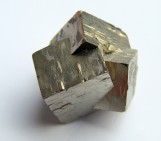Tolbachik is a basaltic volcanic massif lying at the southern end of the Kliuchevskoi group in Kamchatka, Russia. It comprises two overlapping cones: Plosky Tolbachik, a Holocene shield volcano extending to 3 km in diameter; and the older (Pleistocene) Ostry Tolbachik, a sharp-topped stratovolcano reaching some 3,700 m in height.
Eruptions in 1975-76 and 2012-2013 occurred along rift zones situated NE and SSW of the main vents, with spectacular images of the 21st century activity circulating the globe via the internet. As well as being extremely photogenic, Tolbachik is also a hot-bed of unusual minerals, with a whopping 165 minerals recorded at the volcano. Of these, 54 were first discovered at Tolbachik, making it the type locality for a huge number of minerals.
Many of the minerals found at Tolbachik have only been discovered in the last few years, and they keep on coming. A quick search of the Commission on New Minerals, Nomenclature and Classification (CNMNC) list of approved minerals reveals 11 new entries from Tolbachik since January 2013! The new discoveries almost exclusively source from the fumaroles and vents dating from the 1975-76 rift eruption (known as the Great Tolbachik Fissure Eruption), and are thus dominated by oxides, sulphates, chlorides and hydrates. Many have a high percentage of copper (Cu), but other metal constituents include vanadium (V), arsenic (As), selenium (Se) and thallium (Tl).
Before a mineral can be named, it must be fully described in a publication stating details such as the chemical formula, unit cell formula, structural group and crystal system. Until the name of a proposed new mineral is officially ratified by the CNMNC, the mineral in question is given a code which incorporates the year that it was found, its chemical grouping and its principal elemental constituents, e.g., UM2015-01-SiO:FeMg would be the code assigned to olivine, if it were to be discovered next year.
The name of the new mineral is chosen by the describing authors, and is commonly related to the geographical locality of its discovery or a particular property of the mineral. Minerals may also be named after people (as long as he or she is not the author of the initial descriptive publication). Recent examples from Tolbachik include:
- Pauflerite β-VO(SO4) – named after German mineralogist Professor Peter Paufler
- Steklite KAl(SO4)2 – named after the Russian word steklo, meaning glass, because of the mineral’s visual similarity to thin glass platelets
- Coparsite Cu4O2[(As,V)O4]Cl – named after the mineral’s chemical composition

Sulphur-rich deposits around a fumarole on Tolbachik volcano, Kamchatka, Russia. Many new minerals have been discovered here, in just this type of geologic setting. Photo credit: Lena Melekhova.
And not forgetting Tolbachite (CuCl2), which was approved as a mineral in 1983. No prizes for guessing what it was named after!



